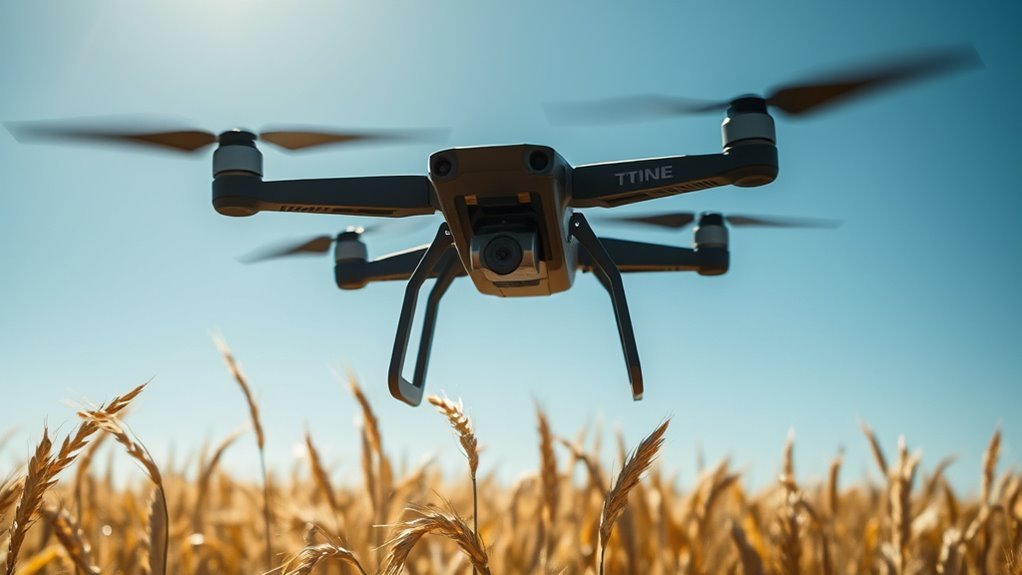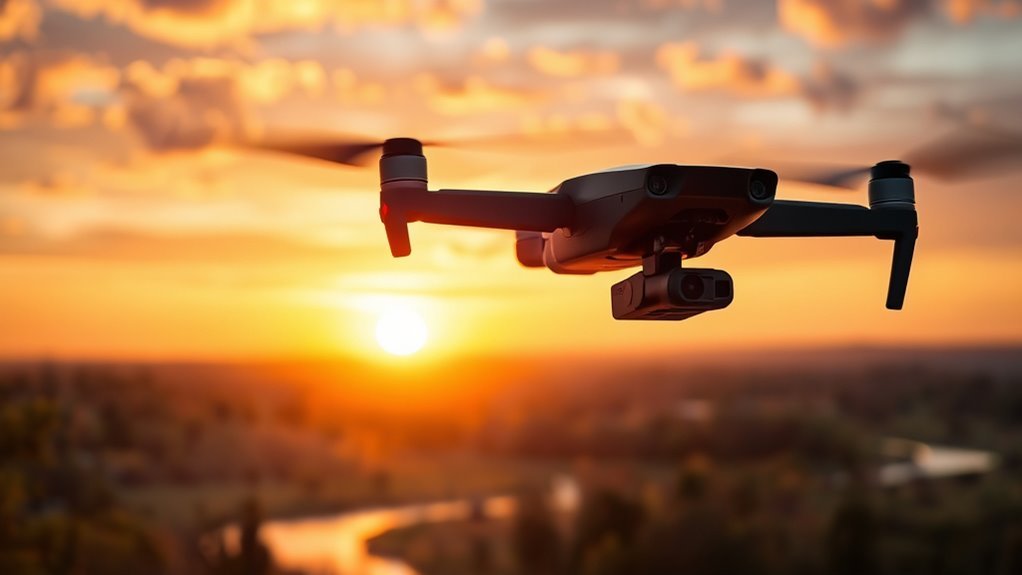Drones produce a range of sounds, from high-pitched whines to low-frequency hums. These sounds largely depend on design factors, such as motor type and propeller shape. Brushless motors tend to create less noise, while propeller size affects sound intensity. Electric drones typically emit a consistent buzzing, whereas gas-powered ones have deeper, throaty roars. Understanding these sound dynamics can enhance your awareness of drone behavior. Explore how different drone types uniquely impact sound interactions.
The Basics of Drone Sounds

Drones, often referred to as UAVs (Unmanned Aerial Vehicles), produce distinct sounds that vary based on their design and operational conditions. The drone soundscape consists primarily of rotor noise, which can range from a high-pitched whine to a low-frequency hum. Factors such as rotor size, motor type, and flight speed influence these sounds. Noise regulation plays a critical role in determining acceptable sound levels, especially in residential areas. Understanding these basic sound characteristics is essential for both operators and communities, as it promotes responsible drone use and minimizes disturbances. By being aware of how your drone’s sound interacts with its environment, you can navigate the balance between technological freedom and noise compliance effectively.
Factors Influencing Drone Noise

When evaluating drone noise, you’ll find that motor type and propeller design play significant roles. Different motors generate varying sound frequencies, while propeller shape and size can amplify or reduce noise levels. Understanding these factors can help you choose a drone that meets your noise preferences. Additionally, the drone’s advanced camera capabilities can also influence its overall design, potentially affecting noise levels during operation. The power-to-weight ratio significantly impacts the efficiency of motor performance, which can further contribute to sound variations during flight.
Motor Type Effects
Although various factors contribute to the overall noise produced by a drone, the type of motor it employs plays a pivotal role in shaping its acoustic profile. Brushless motors, for instance, typically offer superior motor performance compared to brushed alternatives. They not only enhance efficiency but also facilitate noise reduction by minimizing mechanical friction. The quality of the motor affects vibrations, which directly correlate with the sound generated. Additionally, the design and construction materials can influence both how efficiently the motor operates and its noise output. When selecting a drone, consider the motor type carefully, as it considerably impacts your flying experience and the auditory footprint of your drone in various environments.
Propeller Design Influence
While the motor type is essential, the design of the propellers also greatly influences the noise produced by a drone. Factors such as propeller shape and size directly affect how sound waves are generated and propagated. To achieve ideal noise reduction, consider these key elements:
- Blade Width: Thicker blades can reduce noise but may sacrifice efficiency.
- Blade Length: Longer blades generally produce lower frequencies, which may be less noticeable.
- Pitch Angle: A higher pitch can increase thrust but may also amplify noise.
- Material Composition: The choice of materials can dampen vibrations, leading to quieter operation.
Types of Sounds Produced by Drones

Drones produce a variety of sounds that can be categorized based on their operational modes and design features. Generally, these sounds fall into two main types: consistent hums and irregular noise patterns. The consistent hum often emerges from a drone’s rotors spinning at a steady sound frequency, creating a monotone pitch that can be perceived differently based on distance and environmental factors. On the other hand, irregular noises, such as buzzing or whirring, occur during rapid maneuvers or sudden changes in altitude. Your noise perception of these sounds can be influenced by factors like wind and terrain, affecting how invasive or pleasant the sound may feel. Understanding these sound types enhances your awareness of drone behavior and its impact on your surroundings.
The Impact of Drone Design on Sound
As the design of a drone evolves, its acoustic profile changes markedly due to various engineering choices. Factors influencing sound include:
- Rotor shape: Curved blades can enhance lift while lowering noise.
- Material selection: Lightweight, sound-absorbent materials contribute to noise reduction.
- Motor type: Brushless motors often operate more quietly than traditional counterparts.
- Design aesthetics: A streamlined design can minimize air resistance, subsequently reducing noise. Additionally, understanding the impact of signal attenuation can guide engineers in optimizing drone design for quieter operation in various environments.
Sounds of Different Drone Types
When examining the sounds produced by various drone types, you’ll notice distinct differences between electric and gas-powered models. Electric drones typically emit a high-pitched whirring sound, while gas-powered drones generate a deeper, more rumbling noise. Understanding these variations can provide insights into their operational characteristics and applications.
Electric Drone Sounds
While exploring electric drone sounds, you’ll notice a fascinating variety of auditory signatures that differ based on the drone type and its design. These sounds stem from advanced electric drone technology, which influences performance and application. Here are some common sound characteristics:
- Quadcopters: A consistent buzzing, often described as a high-pitched whir.
- Fixed-Wing Drones: A more subtle whoosh, reflecting their aerodynamic design.
- Racing Drones: Sharp, aggressive tones due to rapid motor speed shifts.
- Survey Drones: Softer, rhythmic hums, ideal for prolonged use in electric drone applications.
Each type’s sound profile provides insights into its capabilities and intended use, enhancing your understanding of their operational nuances.
Gas-Powered Drone Noises
Gas-powered drones produce a distinct auditory experience that varies greatly from their electric counterparts, reflecting their mechanical complexity and design. When you operate a gas drone, you’ll immediately notice the deeper, throaty roar generated by the combustion engine. This sound is often accompanied by a rhythmic pulsation, influenced by the engine’s RPM and propeller dynamics. Noise levels can range greatly, typically between 70 to 90 decibels, depending on engine size and tuning. This makes gas drones more audible in outdoor settings, potentially impacting your operational freedom. Understanding these sound characteristics is essential for selecting a drone that aligns with your needs, especially if discretion is a priority. Embrace the unique audio signature of gas-powered technology for your aerial adventures.
Understanding Drone Sounds in Everyday Use
Although you might not always notice them, the sounds produced by drones can vary considerably based on their design, purpose, and operational conditions. Understanding these drone soundscapes is essential, especially as noise regulations become more stringent. Here’s a breakdown of the factors influencing drone sounds in everyday use:
- Propeller design: Different shapes and sizes can alter noise levels.
- Motor type: Electric motors typically produce a quieter sound than gas-powered alternatives.
- Payload: Heavier loads can increase sound intensity due to additional strain on motors.
- Flight altitude: The higher the drone flies, the less noticeable its sound becomes on the ground.
Frequently Asked Questions
Can Drone Sounds Affect Wildlife Behavior?
You might think drone sounds aren’t significant, but they can cause drone disturbances that lead to notable wildlife responses. Understanding these effects is essential for conservation efforts and ensuring harmonious coexistence between technology and nature.
How Can I Reduce Drone Noise During Flights?
To reduce drone noise during flights, implement noise reduction methods like soundproofing techniques. Utilizing dampening materials, modifying propeller designs, and optimizing flight paths can greatly minimize sound output, enhancing your aerial experience without compromising freedom.
Are There Regulations Regarding Drone Noise Levels?
You’ll find that drone noise regulations vary by region, often setting noise level standards to guarantee peaceful coexistence. Understanding these guidelines can help you navigate your flying experience while respecting your surroundings and community.
Do Electric Drones Make Less Noise Than Gas Drones?
Electric drones generally produce less noise than gas drones, showcasing electric drone advantages in quiet operations. Gas drones, with their combustion engines, have inherent disadvantages, contributing to higher noise levels and potential disturbances in sensitive environments.
What Are the Long-Term Impacts of Drone Noise on Communities?
You might not realize it, but drone noise can disrupt community health considerably. Over time, this noise pollution could lead to increased stress levels, sleep disturbances, and overall decline in quality of life for residents.

